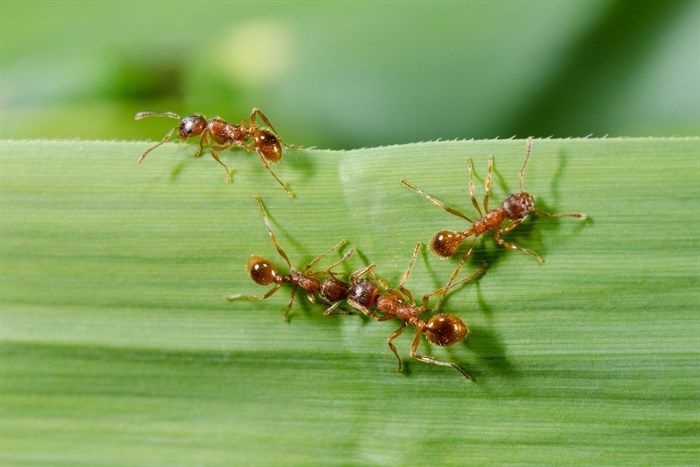
A Thompson Rivers University researcher has discovered European Fire Ants in Naramata.
Image Credit: Shutterstock
April 29, 2015 - 11:38 AM
PENTICTON - A Thompson Rivers University researcher wants to stop a newly-discovered invasive species from getting a foothold in the region.
Dr. Robert J. Higgins, of Thompson Rivers University’s Biological Sciences Department, discovered European Fire Ants on a property in Naramata in the summer of 2013, after analyzing specimens sent to him in 2012.
The site turned out to be a larger infestation than originally thought and since his discovery the ants have reached a stream. The infestation presently covers the equivalent of a city block. He’s a little perplexed the fire ants have made a home in Naramata though.
“They must be finding habitat around leaking irrigation lines. It’s normally a dry environment, and they shouldn’t like it there. It surprises me a bit - it’s unusual,” he says. “I’m concerned. They might spread along the stream, as they favour moist conditions.”
Higgins believes the Naramata infestation began when bedding or landscaping plants with ant-contaminated soil were brought into the area. He hopes attempts this summer will knock the Naramata colonies down before they can spread any further.
“In the bigger picture, it is important people do not move soil of plants out of the affected area,” he says.
Higgins advises gardeners and anyone working with plants to inspect everything coming onto their property for ants.
“Bang the pots at the store. If any ants respond to that disturbance, do not take that plant home,” he advises.
Higgins first identified the species from ant specimens sent to him from Agriculture Canada in 2010. Those specimens were collected in North Vancouver. In June 2011, Higgins also identified the species in a Burnaby community garden.
Higgins describes the history of the species on his website, noting the species was first documented around 1900 in the Boston area. It was only 30 to 40 years ago the species began to significantly spread across the continent, moving into the Maritimes 15 years ago. Up until the Maritime identification, all other identified locations of the species were below the 49th parallel.
Higgins says the species has caused problems along the coast, where the environment is more favourable to the fire ant. A report produced by Thompson Rivers University in July 2014 noted Higgins’ discovery of a wide reaching and growing infestation of fire ant colonies throughout Metro Vancouver, the Fraser Valley and southern Vancouver Island.
Higgins doesn’t expect the ants to gain a foothold in B.C.’s Southern Interior though, simply because the dry environment isn’t favourable to the insect. What concerns him, however, is the potential for the species to spread through soil movement.
“Most locations in the interior aren’t suitable for their survival, but if the soil is moved, it wouldn’t surprise me if one or two more locations became infested,” he says.
Higgins hopes to control the ants through use of a experimental technique first used last year. He's currently looking for a student to hire and has plans to return to the Naramata site later this year.
Higgins plans to find the nest, not an easy task because there is no surface structure, and once found will dig it out and place it in a bucket of 0.25 per cent permethrin solution.
“This will kill a portion of the colony, but will likely miss many queens and some workers who moved into lateral escape tunnels when the shovel first hit the ground,” he says.
The treated soil will be placed back into the ground and over the course of the next 30 to 40 days the degrading permethrin should last long enough in the soil to kill any queens attempting to re-form the nest.
Higgins says previous attempts to kill the colony using freezing, torching or steaming didn’t make the soil inhabitable long enough to kill all of the ants.
Higgins describes the European Fire Ant as a species prone to swarming rapidly and stinging when disturbed. The bad news for this region is the ant's favourite habitat is lawns and gardens.
“It can make standing on grass impossible, as nests often form at densities greater than one per square metre,” Higgins writes on his website, describing an encounter in a North Vancouver backyard in 2011 where he counted four nests within one square metre.
The researcher advises the sting of a fire ant isn’t as painful as a wasp, but people tend to get stung simultaneously before realizing they have stepped on a colony.
"To date there have been no cases of very serious or life threatening reactions to fire ant stings, but some cases of abnormal swelling around the sting have occurred. Some people react more seriously and experience painful and significant swelling, requiring medical care, “ he explains, “If these ants get into parks or campgrounds, they can render them effectively unusable.”

Dr. Robert Higgins in the lab
Image Credit: Photo courtesy Robert Higgins
To contact the reporter for this story, email Steve Arstad at sarstad@infonews.ca or call 250-488-3065. To contact the editor, email mjones@infonews.ca or call 250-718-2724.
News from © iNFOnews, 2015